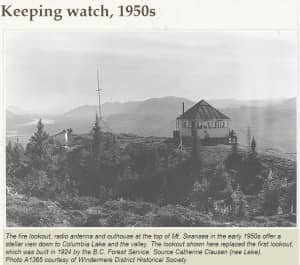Some earlier history of Swansea Mountain.
The mountain range to the east of Lake Windermere is the Stanford Range of the Rockies. It includes Swansea Mountain and Mt. Tegart. They are not much more than the foothills to the higher peaks beyond.
Swansea’s height is 5,655 ft. and Mt. Tegart is 7,810 ft. Mt. Tegart is named for the early day settler, Walker Tegart. Swansea is named by Sam Brewer because of the copper mined there years ago. The copper was taken to Swansea in Wales for concentration.
Years ago an interesting visitor from Wales told me that Wales was long ago named Sweyne’s Eye by the Vikings.
In 1891, the mountain was known as Windermere Mountain. During that year, a trail was constructed to the summit to reach the copper mine owned by Brown, McVittie and Brewer. During that year some 50 tons of copper ore where packed down the trail by packhorses, carrying ordinary pack loads.
At the Salmon Beds (Athalmer), the ore was shipped by barge to Golden, than by train to Vancouver and by sea to Wales. In spite of the circuitous route, the ore was mind at a profit.
In 1897, the Swansea claims were owned by Sam Brewer, Ben Abel, Joe Lake and G.S. Carter. Brewer held two fifth interests and the others each one fifth.
In 1898, a large crew of men was employed in developing the property under the management of Mulholland of Rossland. About this time, a “go-devil” (a mountain sleigh) was used to take the ore to the barges on the river.
In 1924, when the forestry build a lookout hut on the mountain summit, a metallic telephone line was strung on trees along the old pack trail for use of the lookout man.
The hut had one room, with little space for domestic equipment. Except for a bunk, table, chair and stove, the space was filled an Osborne fire finder, and instrument invented by the U.S. Forest Service for locating forest fires. It was set astronomically north and south and sighted like a rifle to bearings.
The equipment also included powerful binoculars and a set of hazard sticks. These were fir sticks, weighing exactly 100 grams when dry. They were weighed five times daily in the fire season to measure the amount of moisture absorbed by the dry fir which would give some indication of dryness on the forest floor.
Records were kept four times daily of sky conditions, wind direction, velocity and humidity.
The lookout man was kept busy and he was in constant touch with the local forest service by telephone and later by radio. His radio reception was excellent, except during electrical storms.
Tex Woods, a lookout man I once interviewed, told me electric storms were alarming. He said the hut had been hit a number of times. If he had to transmit during an electrical storm, he sat on a wooden chair, which had its legs in glass insulators.
It was a time of great concern as every lightning flash was a potential forest fire.
There was also a water source at the summit of Swansea. Water had to be carried up the last steep climb, and Vernon Wood would leave empty pails at the spring when he got his water.
There have always been many visitors to the summit of Swansea for there the geography of the Valley below is spread like a map.
The view is spectacular and well worth the effort in getting there.
By Winifried Weir
Winfried Weir was for 19 years the editor of the local newspaper and is since several years retired.


